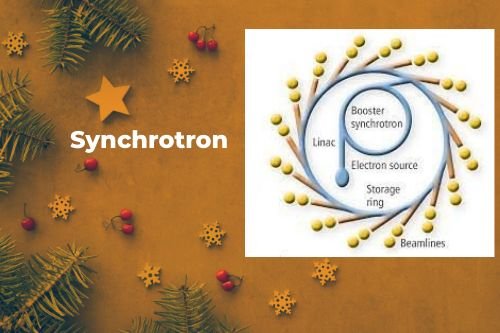Synchrotron, Construction, Working
Synchrotron is a particle accelerator that accelerates electrons to light speed, emitting a continuous spectrum of light with high intensity, broad spectral range, narrow collimation, high polarization, and pulsed time structure.

Synchrotron:
The synchrotron is a cyclic particle accelerator that can accelerate electrons to almost the speed of light.
Principle:
A charged particle when constrained to move in a curved path experiences a centripetal acceleration. This charged particle radiates energy due to this acceleration. A non-relativistic particle emits radiation primarily at its frequency of revolution. However, the radiation pattern is distorted by relativistic effects when the speed of the charged particle approaches the speed of light. The distorted pattern changes to a narrow cone of radiation called synchrotron radiation.
Construction:
The structural design of a synchrocyclotron consists of the following parts
1. Electron gun
2. Linear accelerator
3. Booster ring
4. Storage ring
5. Beamlines
6. Experimental stations
Working:
A synchrotron uses powerful magnets and radio frequency waves to accelerate charged particles. The powerful magnet and radio frequency waves accelerate negatively charged electrons along a stainless steel tube, where they get high speed. The high-speed electrons emit a continuous spectrum of light with various wavelengths and strengths. Scientists can pick whatever wavelength they need for their experiments e.g. visible light, ultraviolet light, or X-rays.
The structural Features:
1. Electron Gun:
The electron gun emits electrons using thermionic emission.
2. Linear Accelerator:
The electron gun feeds electrons into a linear accelerator. These electrons are pushed into linear accelerators by microwave radio frequency fields. The linear accelerator produces electron pulses that travel in an evacuated chamber having low pressure.
3. Booster Ring:
The electrons receive a boost in energy when they circulate under the action of the magnetic field in the booster ring. It means the booster ring accelerates the electron stream further using a strong magnetic field. The strength of the magnetic field increases with the energy of the particles to maintain their orbital radius constant. In addition, the frequency of the accelerating electric field must be maintained or adjusted to be synchronous with the orbital frequency of the electrons. The bunches of electrons turn into a fine beam when the speed of electrons increases close to the speed of light within the evacuated chamber.
4. Storage Ring:
The injection system transfers electrons from the booster ring to the storage ring. The storage ring is not a true circle but a type of polygon. The electrons circulate for four to twelve hours and produce photons. The dipole magnets change the direction of the flow of electrons.
5. Beamlines:
The storage ring is a series of 12 straight sections. After each turn, there is a photon port to allow the light to travel down the beamlines to the research stations.
6. Experimental Stations:
Each beamline has an optic cabin, experimental cabin, and control cabin. The optics cabin has optical instruments used to study the type of radiation. The experimental cabin contains the support mechanism and the environment for the sample study. The control cabin allows the researchers to control the experiments and collect the data. Hence synchronized radiations are put to use in experimental stations.
The major advantage of the synchrotron is that there is no need to restrict the number of revolutions executed by the ion before its exit.
Properties of Synchrotron Radiations:
The main properties of synchrotron radiation depend upon the characteristics of the storage ring.
1. High intensity.
2. Broad and continuous spectral range from infrared to x-region.
3. Natural narrow angular collimation.
4. High degree of polarization.
5. Pulsed time structure.
What's Your Reaction?





















